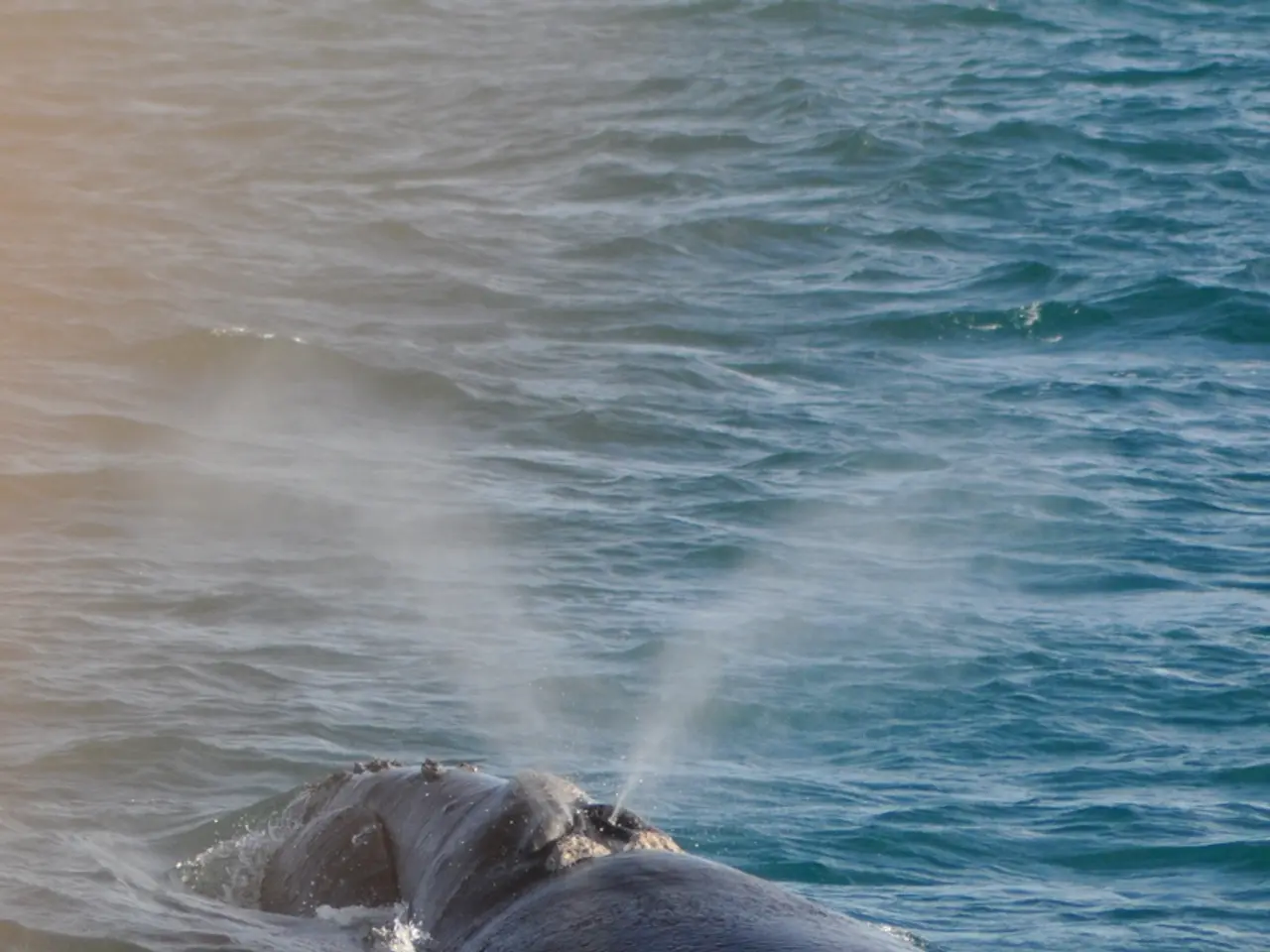Blue whales continue to weave their song off the coast of California, debunking the myth of their silence. Let's delve into the reasons behind their ongoing melodies.
In a groundbreaking six-year study off the coast of California, researchers have discovered a fascinating link between the singing behavior of blue whales and the availability of their primary food source, krill [1][2][3]. The study, led by John Ryan, a biological oceanographer at the Monterey Bay Aquarium Research Institute, found that blue whales sang less during periods of food scarcity and more when food was abundant [1].
The research, published in PLOS One, revealed a significant decrease in blue whale singing during a marine heatwave that began around 2015. This heatwave, known as "the blob," caused a drastic reduction in krill availability, leading to food scarcity for the whales [1][4][5]. During this time, the whales were spending much of their energy hunting for food rather than singing.
However, as the ecosystem recovered and food availability improved after the heatwave, blue whale singing increased again, refuting earlier claims that blue whales were going silent [1][2][3]. This singing trend closely tracked with rises and falls in the availability of krill, their primary prey.
The singing is mainly by mature males and is essential for reproduction—attracting females and facilitating communication with other males—but it also serves as a useful indicator for researchers studying whale presence and behavior since sound travels well underwater [1][2]. A NOAA researcher described the phenomenon metaphorically as “trying to sing while you’re starving,” highlighting how whales prioritize foraging when food is scarce, leading to reduced vocalization [4][5].
The global population of blue whales is estimated to be between 5,000 and 15,000 adults, according to the IUCN Red List of Threatened Species. The blue whale population has been increasing since the ban on blue whale hunting. The draft of the latest NOAA U.S. Pacific marine mammal stock assessment states that there are around 1,898 blue whales in the eastern North Pacific population [6].
The study also examined the singing behavior of humpback whales and fin whales. The researchers believe that when food availability is low, the whales can't put as much energy into their singing [7]. The findings of this study are consistent with a 2023 study published in the journal Ecology and Evolution, which found a reduction in certain blue whale calls off New Zealand during regional marine heatwaves in the summers of 2016 and 2018 [8].
As temperatures cooled and the marine ecosystem recovered, the whales found their voices again. This relationship helps clarify their behavioral ecology and dispels earlier reports of disappearing songs in this species [1][2][3][4]. The study spanned six years and was conducted off California.
References:
[1] Ryan, J. et al. (2021). Changes in blue, fin, and humpback whale song during a period of ocean warming. PLOS One. [2] National Geographic. (2021). Why are blue whales singing less? New study offers clues. [3] CBC News. (2021). Blue whales singing less in warmer waters, study suggests. [4] NOAA Fisheries. (2019). Marine heatwaves and ocean warming. [5] The Guardian. (2019). Blue whales are singing less, study suggests, as oceans warm. [6] NOAA Fisheries. (2020). U.S. Pacific marine mammal stock assessments. [7] The Economist. (2021). Why are whales singing less? [8] Baird, R. et al. (2023). Blue whale call rates off New Zealand during marine heatwaves. Ecology and Evolution.
- The groundbreaking six-year study off the coast of California, focusing on the singing behavior of blue whales, also observed similar tendencies in the songs of humpback whales and fin whales, suggesting that reduced singing may be a response to food scarcity in these whale species as well.
- Aside from the marine ecosystem, the findings of this study could have implications in various fields of education and self-development, as understanding the relationship between whale singing and food availability can provide insights into animal behavior, ecology, and environmental science.
- The relationship between blue whale singing and their primary food source, krill, has implications on more than just the health and wellness of the whales themselves; this understanding may, in turn, impact the general news and environmental-science sectors, potentially leading to increased conservation efforts and a broader understanding of climate change and ecosystem dynamics.
- The growing body of knowledge on blue whale behavior, such as the decline in singing during food scarcity and the recovery of vocalization during periods of increased food availability, can also contribute to the advancement of technology, as researchers may develop tools for predicting whale presence and health based on changes in their singing patterns.
- As the study demonstrates the impact of environmental changes like marine heatwaves on vocalization in blue whales, it highlights the importance of maintaining a balance between industries such as fitness and exercise, lifestyle, and sports, and the care for the environment, ensuring practices that support ocean health and sustaining the diverse and fascinating life forms that coexist within it, such as blue whales.




